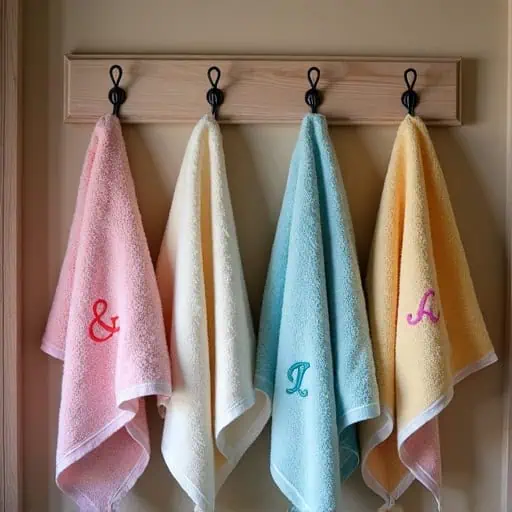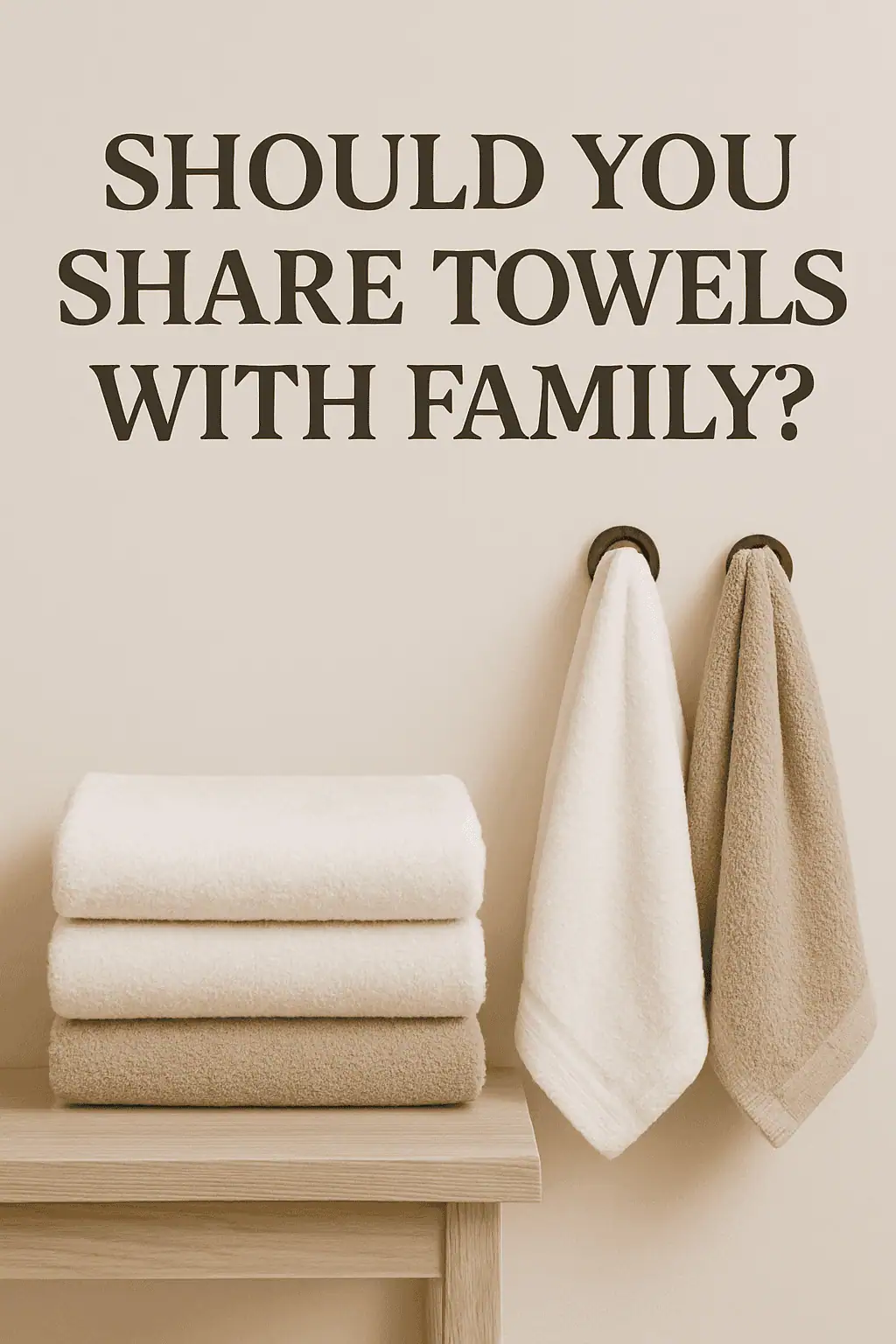Ever grabbed a towel after your sibling, kid—or, let’s be real here—your partner just used it, and thought: “It’s clean enough, right?” Should you share towels with family is a question you might not say out loud, but it’s something every busy home faces. Sharing towels may feel normal, but is it just a harmless shortcut, or actually a secret germ party you want to avoid? Let’s break down the science, hidden risks, and no-stress solutions so your family stays cozy—and truly clean.
| Key Fact | Why It Matters |
|---|---|
| Sharing towels = spreads germs & bacteria | Towels trap moisture, making a breeding ground for bugs 🦠 |
| Kids & older adults are more at risk | Their immune systems are either new or not as tough |
| Avoid sharing if someone’s sick or has a rash | Stops passing on viruses and skin infections |
| Use personal towels for each person | Cuts germ risk & keeps everyone a little healthier |
| Wash family towels often | Fights buildup no matter how careful you are |

🚫 Towel Hygiene 101: Why Sharing Isn’t “Caring”
Here’s the not-so-sparkly reality: towel hygiene isn’t just about smelling fresh. When you share towels, you’re also sharing all the invisible stuff towels collect—sweat, dead skin, body oils, and sometimes way more than that. In a damp bathroom (and let’s face it, most are), germs love to set up shop!
- Moist + Warm = Germ Party:
Bacteria, fungus, and even viruses can linger in towels, especially if they’re never fully dry between uses. Dermatologists say shared towels can spread:- Staph bacteria (responsible for infections and boils)
- Ringworm (fungal—it’s not a worm, but still icky)
- Pink eye (yuck)
- Athlete’s foot and other skin issues
- Not Just Bathroom Talk:
Kitchen and hand towels are even riskier. They’re used by many and sometimes don’t get swapped or washed daily. Studies show more E. coli and stomach bug germs on shared hand towels than toilet handles!
Also read: Foot Towel
Nasty Stuff That Can Hide in Shared Towels
| Germ/Condition | What It Causes | Who’s Most At Risk |
|---|---|---|
| Staph bacteria | Skin infections, boils | Everyone, esp. with cuts |
| Athlete’s foot | Itchy, peeling skin | Kids, gym-goers |
| Pink eye (conjunctivitis) | Red, itchy eye | Kids, contacts wearer |
| E. Coli/Salmonella | Stomach bugs, diarrhea | Little kids, elderly |
| Ringworm/Yeast | Rashes, red rings | Athletes, hot/humid homes |
🙅 Myths & Surprises: “But We’re Family!”
It’s normal to think, “We’re a clean household, what’s the worst that could happen?” Truth is, even healthy people naturally carry stuff on their skin that others might react to. You might not get sick—or, honestly, you might have a superpower-level immune system—but sharing towels can mean passing along stuff you can’t see or smell. Kids, grandparents, and anyone with open scratches or eczema are especially at risk.
Personal confession: I once wondered why my daughter’s eczema flared up every soccer season. Turns out, she kept grabbing her brother’s towel after sweaty practices. Separate towels fixed the problem—no prescription needed.
How Towels Spread Germs (Even If You Can’t See Them)
Towels are basically giant sponges for your skin’s leftovers. Picture this: after a shower, even if you’re “clean,” your towel’s still picking up millions of dead skin cells and stray bacteria. Leave it damp, and bacteria and fungus multiply fast—double trouble if someone else grabs it before it’s dry.
Quick List: When Sharing is Extra Risky
- Someone is sick (colds, flu, stomach bug)
- Visible rashes, wounds, or eczema outbreaks
- After gym, pool, or sports (locker room germs!)
- Babies, toddlers, or elderly in the house
Which Towels Are Riskiest to Share? When “Just This Once” Isn’t Worth It
It might sound picky, but not all towels carry the same germ risks when shared—some are way worse offenders. Here’s what you need to know to dodge invisible problems later.
- Bath Towels:
Big, fluffy, and slow to dry—these are prime real estate for germs, especially in a steamy bathroom. Using them after someone else’s shower (or sweat session) can spread things like staph, ringworm, or athlete’s foot. Anyone with even a tiny cut is at higher risk. - Hand Towels:
Usually see the most “traffic” per day. Kitchen and bathroom hand towels often pick up E. coli, Salmonella, and viral bugs, especially if not swapped out daily. Several studies show these towels can be dirtier than toilet handles—yikes! - Washcloths/Face Towels:
Used on sensitive skin (face, eyes, cuts). Sharing = risk of pink eye, skin rashes, and cold sores, since they directly touch mucous membranes and breakouts. - Kitchen Towels:
Double-duty for messes, food prep, hands, faces—Germ Super Bowl! Even more so if they’re the shared “wipe everything” towel in the kitchen.
| Towel Type | Germ Risk If Shared | Why |
|---|---|---|
| Bath Towel | High | Stays damp, touches whole body |
| Hand Towel | Very High | Many users, less time to dry |
| Washcloth | High | Direct contact with face/eyes/broken skin |
| Kitchen Towel | Very High | Touches food, hands, counters, faces |
| Guest Towel | Moderate | Usually short-term use, but many hands |
How to Practice Family Towel Hygiene: Expert-Backed, Simple Rules
You don’t need a new set of linen rules for each day—just some down-to-earth, consistent habits:
1. Assign Personal or Color-Coded Towels
- Give each person in the house their own towel (label or pick a unique color).
- Even simple stickers or sharpie initials work—keeps mix-ups rare.
- Swap out towels every 3–4 uses, and right away if they’re damp, smell musty, or someone is sick.
2. Wash Towels Often—and Hot
- Aim for hot water (at least 60°C/140°F) to zap most germs.
- In a pinch, use the hottest your towel label allows.
- Don’t load the washer with too many towels: they need room to get truly clean.
3. Dry Towels All The Way
- Always hang towels flat to dry—avoid wadding up or tossing onto a hook in a pile.
- If your bathroom stays damp, air towels outside or use a dryer until fully dry before stacking them for storage.
4. Guest/Hand Towels
- In bedrooms or shared bathrooms, swap hand towels daily, faster if guests come over or anyone’s under the weather.
- For big families, it helps to have a “today’s hand towel” system using a different color each day.
5. Pause Sharing During Sickness or Flare-Ups
- If anyone in the house has a rash, fungal infection, cold, or open cut—no towel sharing, period.
- Same rule for sharing after sports, gym, or pool use.
FAQ—Family Towel Hygiene, Fast!
- Q: My kids ALWAYS mix up their towels. Am I doomed?
A: Nope! Use bold colors, initials, or even a “hook per person” system. Small baskets with their name near the bathroom also help. - Q: Does antibacterial detergent help?
A: A bit, but nothing beats hot water and proper drying. Scents don’t clean—heat and time do. - Q: What if someone is immunocompromised?
A: Be extra strict: their towel gets separately washed and never shared, no exceptions. - Q: Emergency—no clean towel, what now?
A: In a true pinch, use a clean T-shirt or pillowcase, then wash up and restock towels ASAP.
Germs & Infections Spread by Sharing Towels
| What You Can Catch | What It Causes | Extra Risk For… |
|---|---|---|
| Staph bacteria (MRSA) | Boils, skin infections | Cuts, eczema, weak immune system |
| Fungi (ringworm) | Red, itchy rashes | Kids, athletes, humid homes |
| Athlete’s foot | Peeling, itchy feet | Shoeless kids, locker room users |
| Pink eye | Eye redness, itching | Contacts wearers, all ages |
| E. Coli/Salmonella | GI issues, diarrhea | Younger, older, immune weakened |
ALso read:
Wrap-Up: Keep “Sharing” for Family Memories, Not Towels!
Sharing towels in your family isn’t worth the silent trade-off—bacteria, fungi, and viruses can hang around, waiting to cause drama (the invisible kind). The best family towel habit? Make sure everyone has their own, swap out regularly, and wash hot.
Try a “No Sharing Challenge” at home for a week—even the most skeptical kids usually like claiming a color for themselves.
Questions or full-blown towel chaos? Shoot your story my way—I guarantee you’re not the only one dealing with towel mix-ups and germ drama.
🦠 Clean towels = happy skin, fewer sniffles, and one less thing to worry about!

